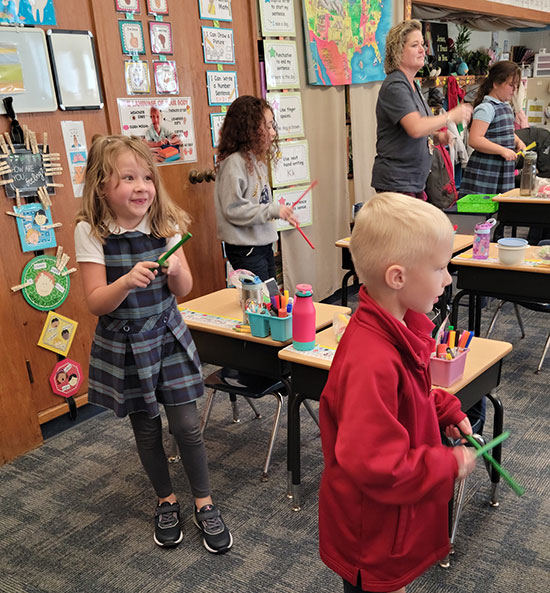
Clockwise from right, first-graders Elijah Carter, Aila Catalano, Nyla Vesey, aide Erin Burns and Aurora Branaman dance and hit sticks to the music of Los Machetes during music class at St. Paul the Apostle Catholic School in Davenport.
By Anne Marie Amacher
The Catholic Messenger
DAVENPORT — St. Paul the Apostle Catholic School recently participated in Hispanic Heritage Month, the school’s second annual celebration to help increase cultural awareness.
Hispanic Heritage Month is a national celebration held Sept. 15 to Oct. 15. “Each year we will add a new culture to celebrate,” said Principal Julie Delaney. “We celebrate Black History Month, Hispanic Heritage Month and we will add Asian/Pacific American Heritage Month next May.”
Inspiration for St. Paul’s participation in Hispanic Heritage Month began after Delaney and Assistant Principal Octavia Houtekier-Boyd attended the Latino Enrollment Institute (LEI), which is part of the University of Notre Dame’s Catholic School Advantage program.
“One of the purposes of the Latino Enrollment Institute is to help schools better serve our Latino students. Educating our student body about the beauty and fullness of the Hispanic culture helps to serve not only our Latino families better, but also to celebrate the diversity of all the students,” Delaney said.
For this year’s celebration, teachers researched and developed activities to use in their classrooms based on a country they chose: kindergarten-Mexico, first grade-Ecuador, second grade-Chile, third grade-Spain, fourth grade-Peru, fifth grade-Venezuela, sixth grade-Guatemala, seventh grade-Dominican Republic and eighth grade-Argentina. Students learned about their country’s map, food, music, flag, famous people, landmarks, holidays, saints and religion.
Music teacher Cathy Hannon invited The Catholic Messenger into her kindergarten and first-grade classes where the students showed off their Spanish singing skills, played a game with a song and used musical instruments while dancing.
“It’s important to teach children respect and appreciation for all cultures,” she said. “We are all God’s children. As they grow, our hope is that they will see cultural diversity doesn’t divide us, rather it unites us. When we respect each other and appreciate our differences, we can’t hate, we can only love.”
Students received extensive lessons in Hispanic culture during art class, Delaney said. One example involved the country of El Salvador. Articles were available on traditional artwork — folk art crosses and street art — and students viewed maps, learned about traditions and food, and about St. Oscar Romero, a martyred bishop from that country.
First-graders learned about the annual migration of the Monarch butterfly to Mexico and created a collage. Second-graders studied artist Joan Miro of Spain who created childlike, whimsical abstract and surrealist artwork. Third-graders learned of Frida Kahlo, a famous self-portrait artist from Mexico. Fourth-graders studied sugar skulls from Villa Gomez, and then created a sugar skull with bright-colored paper and different shapes and patterns, Delaney noted.
Fifth-graders learned about molas and folk art animals from Panama. Sixth-graders studied Diego Rivera’s collaborative pastel murals and paintings and watched a video. Seventh-graders created a large painting of Monarch butterflies and eighth-graders learned about watercolor crystals by Lizeth Prieto of Peru. The students will draw and paint using that style.











